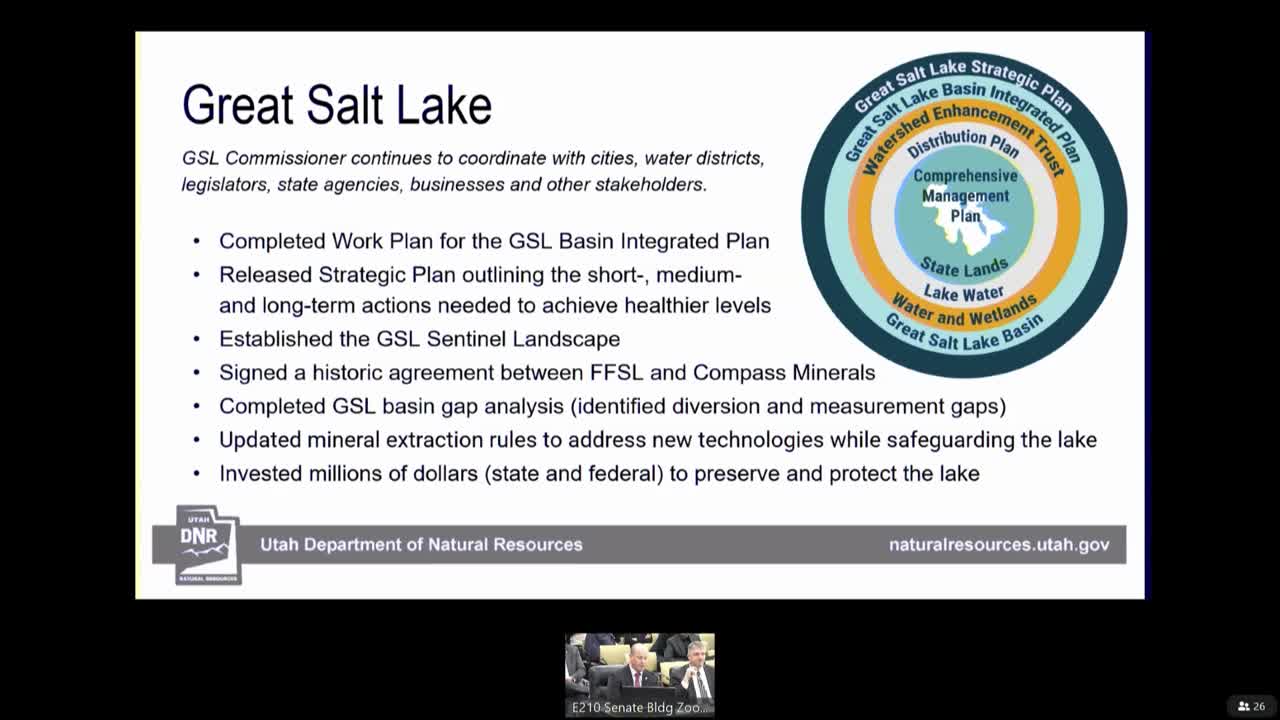Utah launches Sentinel Landscape plan to protect Great Salt Lake and boost energy production
This article was created by AI summarizing key points discussed. AI makes mistakes, so for full details and context, please refer to the video of the full meeting. Please report any errors so we can fix them. Report an error »

The recent meeting of the Natural Resources, Agriculture, and Environmental Quality Appropriations Subcommittee in Utah highlighted significant developments regarding the Great Salt Lake and the state's energy strategy, both of which have direct implications for local communities.
One of the key discussions centered on the Great Salt Lake, where officials announced the completion of a strategic plan aimed at protecting this vital resource. The plan includes the establishment of the Sentinel Landscape, a collaborative effort with the Department of Defense to safeguard military installations around the lake, such as Hill Air Force Base and the Tooele Army Depot. This initiative not only aims to enhance environmental quality but also ensures the continued operation of these critical defense assets.
Additionally, the state has entered into historic agreements with mineral companies, particularly Compass Minerals, to conserve water resources. These agreements are expected to save thousands of acre-feet of water, providing certainty for businesses while addressing the fluctuating water levels of the lake. The state has committed $1 million to further protect and preserve the Great Salt Lake, underscoring its importance as a top priority for Utah.
Water conditions across the state were also a focal point of the meeting. Current reservoir levels are at 76%, which is 20% above average, thanks to favorable weather in recent years. However, concerns were raised about the emerging drought conditions in Southern Utah, highlighting the need for continued investments in drought resilience programs. The discussion emphasized that drought is a recurring challenge in the region, necessitating proactive measures to ensure water availability for residents and agriculture.
On the energy front, the state is pursuing ambitious plans to double its energy production capacity over the next decade through the launch of Operation Gigawatts. Over $400 million in grants have been awarded to improve grid efficiency, with a focus on renewable energy sources like geothermal and nuclear power. This shift is crucial as 67% of existing power plants are scheduled to be offline within the next 20 years, creating an urgent need for new energy resources to meet growing demand from industries such as data centers and artificial intelligence.
The meeting concluded with a consensus on the importance of these initiatives for the future of Utah's environment and economy. As the state navigates challenges related to water scarcity and energy demands, the decisions made in this meeting will play a pivotal role in shaping a sustainable and resilient future for its residents.
One of the key discussions centered on the Great Salt Lake, where officials announced the completion of a strategic plan aimed at protecting this vital resource. The plan includes the establishment of the Sentinel Landscape, a collaborative effort with the Department of Defense to safeguard military installations around the lake, such as Hill Air Force Base and the Tooele Army Depot. This initiative not only aims to enhance environmental quality but also ensures the continued operation of these critical defense assets.
Additionally, the state has entered into historic agreements with mineral companies, particularly Compass Minerals, to conserve water resources. These agreements are expected to save thousands of acre-feet of water, providing certainty for businesses while addressing the fluctuating water levels of the lake. The state has committed $1 million to further protect and preserve the Great Salt Lake, underscoring its importance as a top priority for Utah.
Water conditions across the state were also a focal point of the meeting. Current reservoir levels are at 76%, which is 20% above average, thanks to favorable weather in recent years. However, concerns were raised about the emerging drought conditions in Southern Utah, highlighting the need for continued investments in drought resilience programs. The discussion emphasized that drought is a recurring challenge in the region, necessitating proactive measures to ensure water availability for residents and agriculture.
On the energy front, the state is pursuing ambitious plans to double its energy production capacity over the next decade through the launch of Operation Gigawatts. Over $400 million in grants have been awarded to improve grid efficiency, with a focus on renewable energy sources like geothermal and nuclear power. This shift is crucial as 67% of existing power plants are scheduled to be offline within the next 20 years, creating an urgent need for new energy resources to meet growing demand from industries such as data centers and artificial intelligence.
The meeting concluded with a consensus on the importance of these initiatives for the future of Utah's environment and economy. As the state navigates challenges related to water scarcity and energy demands, the decisions made in this meeting will play a pivotal role in shaping a sustainable and resilient future for its residents.
View full meeting
This article is based on a recent meeting—watch the full video and explore the complete transcript for deeper insights into the discussion.
View full meeting